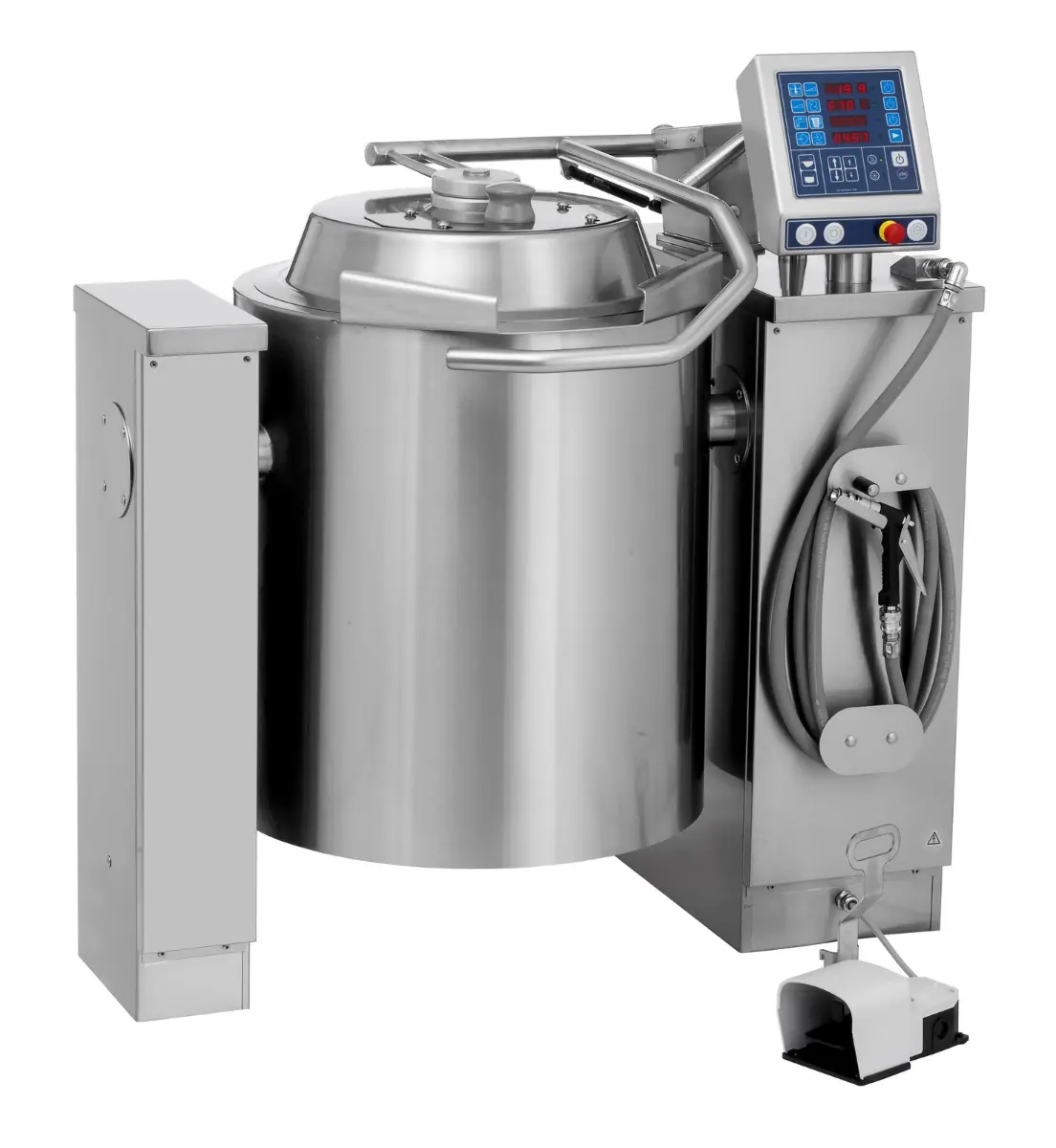Mixer kettles are redefining restaurant efficiency with automation, consistency, and flavor control.
Let’s be real — every kitchen’s a battlefield. There’s the constant hiss of boiling pots, the clang of pans, that one sous chef yelling for more onions, and the eternal prayer that the soup won’t scorch again.
Now imagine a quiet, stainless-steel beast that doesn’t just cook but mixes, stirs, chills, and cleans itself. No, it’s not science fiction. It’s called a mixer kettle, and trust me — once you’ve used one, you’ll never go back to old-school pots.
This is why it’s not surprising that commercial kitchen owners are investing in state-of-the-art mixer kettles to facilitate cook chill process. I’ve worked with restaurant owners who’ve tried everything from oversized stockpots to high-end blenders, and they all say the same thing afterward:
“Should’ve bought the mixer kettle first.”
So… what’s the fuss about? Let’s unpack this game-changer in plain English.
Contents
What Exactly Is a Mixer Kettle (and Why Should You Care)?
Think of a mixer kettle as the Swiss Army knife of commercial kitchen equipment. It’s a big, beautiful metal cauldron that heats, cools, stirs, and emulsifies — all while keeping your food at just the right temperature.
Whether you’re running a 5-star hotel kitchen, a corner café, or a school canteen, this thing’s like an extra pair of reliable hands that never get tired.
Here’s a quick comparison table for context:
| Feature | Mixer Kettle | Traditional Pot | Industrial Blender |
| Heating Control | Precise digital thermostat | Manual flame | None |
| Mixing Consistency | Automated, uniform | Depends on human muscle | Partial |
| Batch Size | 50–500L | Limited | Small |
| Cleaning | Self-clean cycle | Manual scrubbing | Manual |
| Energy Efficiency | 25–30% lower | Variable | Moderate |
Verdict: The kettle wins — every time.
1. How Does a Mixer Kettle Save Space and Boost Versatility?
Alright, let’s talk kitchen real estate. Every square foot counts, right?
One of the coolest things about a mixer kettle is how much it can do in a single unit.
You can:
- Whip soups, sauces, and gravies
- Puree veggies and make marinades
- Gently mix salads without turning them to mush
- Melt chocolate with surgical precision
- Even cook cold dishes with consistent temp control
Translation: fewer appliances cluttering your counters. More room for creativity (and maybe that espresso machine you’ve been eyeing).
Sample Menu Output: What You Can Do with a Mixer Kettle
| Dish Type | Mixer Kettle Function | Benefit |
| Soups & Broths | Heat + Stir | Prevents burning & uneven texture |
| Marinades & Sauces | Emulsify + Cool | Perfect balance, no separation |
| Desserts & Custards | Whip + Precise Temp | Smooth, glossy finish |
| Chocolates | Melt + Hold | Consistent tempering every time |
You see the pattern? It’s the ultimate multitasker.
If Gordon Ramsay had one of these during Hell’s Kitchen, half those meltdowns wouldn’t have happened.
2. Can It Really Guarantee Consistency Every Time?
Oh yes. And that’s where the cook and chill process shines.
Here’s the deal — when you manually stir a 100-liter batch of soup, no two pots ever come out exactly the same. Maybe one’s thicker, one’s saltier, one’s burnt on the bottom (don’t pretend it’s never happened).
But with a mixer kettle? The machine keeps the same rotation speed, temperature, and mixing pattern every single time.
A quick look at the difference:
| Process | Manual | Mixer Kettle |
| Stirring | Uneven | Even, automated |
| Temperature | Hard to control | Sensor-based accuracy |
| Outcome | Inconsistent | Perfect batch every time |
Stat check: Kitchens using automated kettles report up to 40% fewer product reworks and 25% faster batch completion.
So yeah — consistency isn’t a buzzword here. It’s a business advantage.
3. Is It Really That Easy to Use?
You bet. These machines were built with chefs (and tired wrists) in mind.
Modern kettles come with digital touch panels, pre-programmed recipes, and tilt-out mechanisms for easy pouring.
I remember the first time I saw one — I thought it’d take a week to learn. But ten minutes later, I was running a batch of tomato soup like I’d been doing it for years.
Typical workflow:
- Add ingredients
- Select temperature and mixing speed
- Let it run (grab coffee)
- Tilt and pour
- Hit “Auto-Clean”
Done.
No mystery. No manual labor marathons.
4. Can It Handle Large Batches Without a Sweat?
Let’s put it this way: if your old pot was a hatchback, the mixer kettle’s a freight truck.
You can cook, say, 500 liters of soup or 100 kg of mashed potatoes — all in one shot.
That means fewer batches, fewer burners, and way fewer headaches during rush hour.
Here’s a quick output comparison chart:
| Dish | Manual Time (min) | Mixer Kettle Time (min) | Time Saved |
| Tomato Soup (200L) | 90 | 45 | 50% |
| Bechamel Sauce (100L) | 70 | 35 | 50% |
| Potato Mash (150kg) | 120 | 60 | 50% |
Efficiency like that isn’t just impressive — it’s cost-saving.
Multiply those minutes by staff wages, and suddenly that pricey kettle looks like a long-term investment, not an expense.
5. What About Cleaning and Maintenance?
Ah, the part nobody likes — cleanup.
Well, here’s the magic: the auto-wash feature handles most of it. It uses 80% less water and detergent, and it’s done in about 15 minutes.
One chef I interviewed told me:
“I used to spend 45 minutes scrubbing pots after every lunch service. Now, I press one button, and I’m done before dessert.”
That’s not marketing. That’s sanity restored.
Hidden Pitfalls: What to Know Before You Buy
Now, let’s be fair. Mixer kettles aren’t perfect. A few things to keep in mind:
| Drawback | What It Means | Mitigation |
| High upfront cost | $8k–$20k range | Long-term ROI offsets it |
| Requires 3-phase power | Needs professional setup | Plan kitchen wiring |
| Maintenance costs | Regular descaling, gasket checks | Get a service contract |
| Learning curve | Staff training | Most chefs adapt within days |
In short — not deal-breakers, but worth planning for. The ROI, though? Unbeatable.
Bonus: Energy & Food Safety Benefits
- Energy Efficiency: Most models save 25–30% electricity thanks to closed-loop heating.
- HACCP & Food Safety: Automated temperature control prevents bacterial growth.
- Sustainability: Lower water and detergent use = greener operations.
If your restaurant’s chasing eco-certification or just trying to cut utility bills, this machine makes that easier too.
So, Should You Invest in a Mixer Kettle?
If you run a commercial kitchen, love consistency, and hate wasting time, yes.
A mixer kettle is like hiring a sous chef who never complains, never burns soup, and cleans up afterward. Users have reported saving at least 80% in water and detergent and as much as 45 minutes of cleaning time. This frees your staff up to focus on other duties.
Sure, it’s not cheap. But if you’re running 100+ covers a day, it’ll pay for itself in months — not years.
Key Takeaways
| Benefit | Impact |
| Multi-functional | Saves space, adds menu variety |
| Consistent results | Enhances brand reputation |
| Easy operation | Less training, fewer errors |
| Large capacity | Handles peak rush hours |
| Auto-clean | Reduces labor cost and downtime |
Final Thoughts
Every successful kitchen I’ve consulted for eventually hits the same realization — automation doesn’t replace passion, it amplifies it.
You still bring the flavor, creativity, and love for food. The mixer kettle just handles the heavy lifting (literally).
So if your cook and chill process feels like a daily wrestling match — maybe it’s time to call in some stainless-steel reinforcements.








